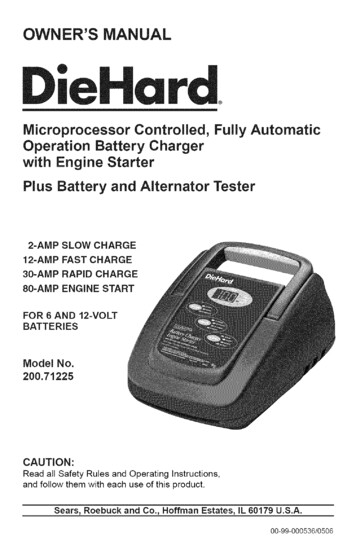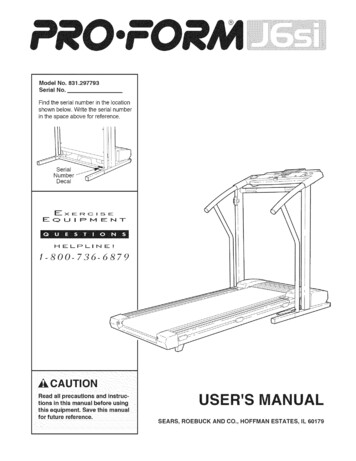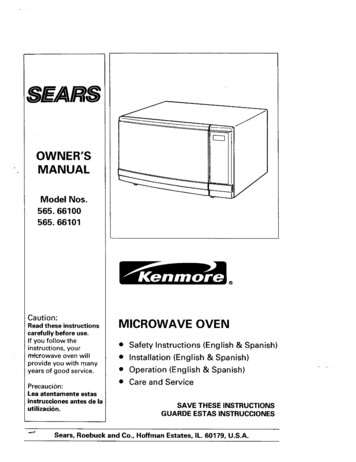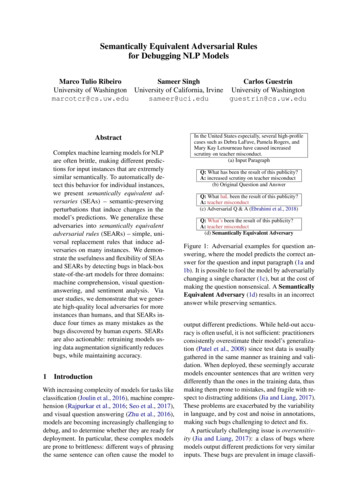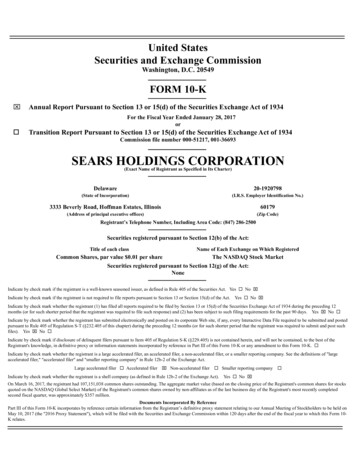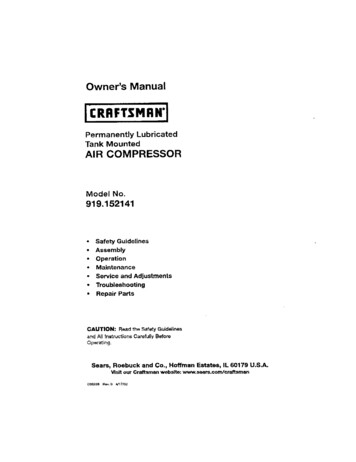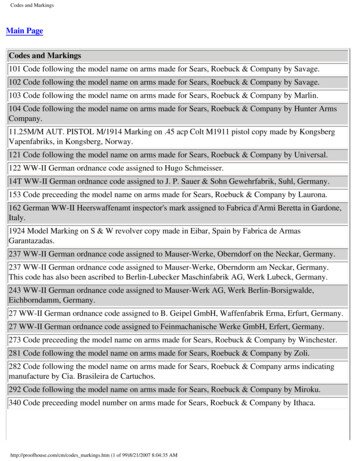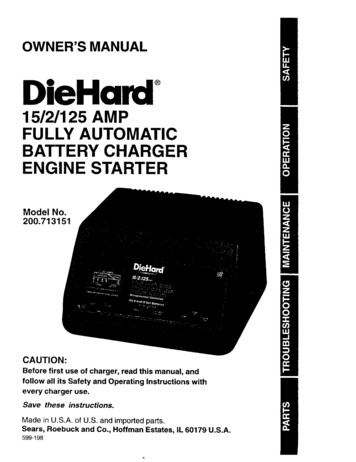
Transcription
OWNER'SMANUALDieHard 15/2/125 AMPFULLY AUTOMATICBATTERY CHARGERENGINE STARTERModel No.200.713151CAUTION:Before first use of charger,read this manual, andfollow all its Safety and Operatingevery charger use.SavetheseInstructionswithinstructions.Made in U.S.A. of U.S. and imported parts.Sears, Roebuck and Co., Hoffman Estates, IL 60179 U.S.A.599-198
WARRANTY.2SAFETY .3Important Safety Instructions .OPERATION3.5Before Using Your Battery Charger .5Plugging it in .5Using an extension cord .5Preparing Your Battery to be Charged .6Using Your Battery Charger .6Setting the controls .6Charging your battery .8Inside vehicle .8Outside vehicle .9Using the Engine Start Feature .10Calculating Charge Time .11MAINTENANCEAND CARE .TROUBLESHOOTING.PARTS .Wiring Diagram .12131415Please read this Owner's Manual before using your Battery ChargerThe DieHard model 200.713151, Fully Automatic Battery Charger/Engine Starter, offersa wide range of features for home or light commercial use. This manual will show youhow to use your charger safely and effectively. Please read and follow these instructionsand precautions carefully.FULLTHREEYEARWARRANTYWithin three years from the date of purchase, if this battery charger fails due to adefect in materials or workmanship, RETURN IT TO THE PLACE OF PURCHASE,and it will be repaired or replaced free of charge.Thiswarranty gives you specific legal rights, and you may also have other rightswhichvary fromstate to state.Sears, Roebuck and Co., Dept. 817WA, Hoffman Estates, IL 60179O
WARNING:HELP US HELP YOU --To reduce the risk ofexplosion, explosive gases, or injurywhile using your battery charger, followthe precautions listed below: Remember: Place charger as far away from batterybeing charged as the charger cableswill permit.Read all instructions and cautionsprinted on the battery charger,battery, and vehicle or equipmentusing battery. Usechargeronlyon Do not expose charger to rain or snow. Never charge a frozen battery. Ifbatteryfluid (electrolyte) becomesfrozen, bring battery into a warm areato thaw before you begin charging.lead-acidtyperechargeable batteries, such asthose used in cars, trucks, tractors, Never allow battery acid to drip oncharger when reading specific gravityorfilling battery.airplanes, vans, RV's, trollingmotors, etc. This charger is notintended to supply power to a lowvoltage electrical system other thanin an automotive application. Never set a battery on top of thecharger. Never place charger directly abovebattery being charged. The gases fromthe battery will corrodeand damage the charger.Use only attachments recommended or sold by manufacturer.The use of attachments notrecommended by the manufacturermay result in fire, electric shock, orinjury. Never use charger for charging dry cellbatteries that are commonly used withhome appliances like radios, stereos,remote controls, etc. These batteriesmay burst and cause personal injury.Do not disassemble charger.Takeit to a qualified service professionalif service or repair is required.Incorrect assembly may result in fireor electrical shock. Never touch the battery clampstogether when the charger is on. Youwill cause a spark.To reduce risk of electrical shock, Never operate charger if it hasreceived a hard blow, been dropped, orotherwise damaged. Take it to aqualified professional for inspection andrepair.unplug the charger from the outletbefore attempting any maintenanceorcleaning. Always charge battery in a wellventilated area. Be sure to position the charger powercord to prevent it from being steppedon, tripped over, or damaged.Battery chargers get hot duringoperation and must have properventilation. Air needs to flow around Never pull out the plug by the cordwhen unplugging the charger. Pullingon the cord may cause damage to thecord or the plug.entire charger. Do not set charger on flammablematerials like carpeting, upholstery,paper, cardboard etc. Charger maydamage leather and melt plasticand rubber. Do not operate the charger if it has adamaged power cord or plug. Have thecord replaced.3
Personal Safety PrecautionsFor your own personal safety, please follow the following Wear complete eye and clothingprotection when working with leadacid batteries. Be sure that someone is within rangeof your voice to come to your aid ifneeded while you work with or are neara lead-acid battery. Have plenty of fresh water and soapnearby for use in case battery acidcontacts your eyes, skin, or clothing. Ifthis happens, wash immediately withsoap and water. Then get medicalattention. Avoid touching your eyes whileworking with a battery. Acid padicles(corrosion) may get into your eyes. Ifthis OCCUrs,flush eyes immediatelywith running cold water for at least 10minutes. Then immediately get medicalattention.precautions: Remove all personal metal itemsfrom your body, such as rings,bracelets, necklaces, and watcheswhile working with a lead-acid battery.A battery can produce a short circuitcurrent high enough to weld a ring (orthe like) to metal, causing a severebum. Take care not to drop any metal tool ormetal object onto the battery. This mayspark or short circuit the battery oranother electrical device that maycause an explosion. Always operate your battery charger inan open, well ventilated area. Never smoke or allow a spark or flamein the vicinity of the battery or engine.Batteries generate explosive gases. Neutralize any acid spills thoroughlywith baking soda before attempting toclean up.
It is important to understand your charger's requirements.This section will tell youabout your charger's electrical requirements and how to prepare a battery forcharging.PLUGGINGUSING AN EXTENSIONIT INCORDThe use of an extension cord is notWARNING: Electrical Shock Hazard.Be sure that the power cord fits properlyinto the outlet. If not, have a qualifiedtechnician install a proper outlet. Neveralter the AC cord or plug provided.recommended. If you must use anextension cord, please make surethat you follow these guidelines: Improper connection can result inelectrical shock.Make sure that the pins on charger'spower cord fit firmly into the extensioncord, and that the extensioncord fits firmly into the receptacle.Your charger requires a 120V receptacleinstalled according to all local codes andordinances. Checkthatthe extension cord isproperly wired and in good electricalcondition.Make sure that the wire size is largeenough for its length and for the ACampere rating as specified in thechart below.MINIMUM RECOMMENDEDEXTENSIONCORDiiiLength of Cord, in Feet2550 100 150AWG* Size of Cord1818"AWG American5Wire Gauge1614
It is important that you road and follow these guidelines while you are preparing tocharge yourbattery.Make sure that you have a 12 volt or6 volt lead-acid battery. Set theselector switch to match the voltagerating of the battery to be charged.Clean the battery terminals. Becareful to keep corrosion fromgetting in or around your eyes.For batteries with removable cellcaps, if required by the manufacturer,add distilled water to each celluntil the battery acid roaches thelevel recommended. This will helppurge excessive gases from thecells. Be careful not to overfill. If youhave a sealed battery without cellcaps, no action is necessary.Continue to the next step listed below.Take time to read all batterymanufacturer's specific precautions,such as removing or not removingcell caps while charging, andrecommended rates of charge. Wear safety glasses. See additional"Personal Safety Precautions" onpage 4. Be sure that the area around thebattery is well ventilated while it isbeing charged.If it is necessary to remove thebattery from the vehicle to charge it,always remove the groundedterminal from the battery first. Turnoff all vehicle accessories to avoidsparks from occurring.NOTE: A marine battery installed in aboat must be removed and charged onshore.For best results from your battery charger, learn to use it properly. This section will tellyou how to set the controls, how to charge a battery in or out of a vehicle, and how to usethe engine start features.SE'I-rlNG THE CONTROLSAll controls are located on the front of thecharger. Follow these instructionsto obtain the correct charge level for yourbattery.SELECTORSWITCHES:Your charger has three switches: Use the right switch to select a chargerate--2 AMP charge, 15 AMP charge,or 125 AMP ENGINE START feature.Battery Voltage:Select the voltage of your battery. Themost common applications will be 12 volt. Use the left switch to match the batteryvoltage--either6 or 12 volt. Use the centerswitchto select acharge type--MANUAL,AUTOMATICDEEP CYCLE, or AUTOMATICREGULAR.6 VOLT12 VOLT
AMMETER:The ammeter indicates the measuredCharge Type: Use the MANUAL setting only ifyoucheck the charging progress frequently.The charger will not stop charging whenthe battery reaches full charge, possiblydamaging the battery if left on too long.You must monitor and unplug thecharger when battery is fully charged. Use the AUTOMATICamount of amperes being drawn by thebattery. When you first start charging abattery, the reading will be high, withthe needle near 15 using the 15 ampcharging rate. In the MANUAL setting, as the batterycharges, the needle will fall to about 7or 8 amps, indicating a charged battery.DEEP-CYCLEsetting for all deep-cycle batterycharging. The charger will automaticallystop charging when the battery reachesfull charge and begin charging againwhen battery requires.In either AUTOMATIC setting, theneedle will fall to zero and the chargerwill shut off when the charger's controlcircuit senses a full charge. A freshlycharged battery's voltage will dropshortly after charging stops, and thecharger, if left connected, may resumecharging. This off-and-on cycling willcontinue untilthe battery's voltage nolonger drops enough to restart thecharger. Use the AUTOMATIC REGULAR settingfor all but deep-cycle batteries. Thecharger will automatically stop chargingwhen the battery reaches full chargeand begin charging again when batteryrequires. A severely discharged battery may nothave enough charge to start the controlcircuit in an automatic setting. In thiscase, charge on manual until thebattery has enough charge to accept anautomatic setting.AUTOMATIC At the 2 amp charging rate you willnotice very little needle movement.When cranking the engine while usingthe ENGINE START feature, the needlewill swing into the Start (red) area of thescale.DEEP CYCLEMANUALllI[IREGULARIAoTOMATICI!Charge Rate: Use the 2 AMP charge rate setting forcharging small batteries and warminglarge batteries.The lower the chargerate, the longer it will take to chargethe battery. 0 10 15 125CHECK OBA'FrERYLED INDICATORS:Two LED INDICATORS provideinformation on the state of charge byglowing steadily or blinking at differentintervals: Use the 125 AMP ENGINE STARTsetting only to assist in cranking theengine.GREEN, FAST BLINK:When the charger is charging a battery,the green LED INDICATOR will blinkrapidly, approximately twice per second.15 AMPII . I 5O FULLCHARGE Use the 15 AMP rate setting forautomotive, deep cycle and other largebatteries.2 AMPDC AMPSSTARTNGINE7
GREEN, STEADY GLOW: In AUTOMATIC, the green LEDindicator will glow steadily and themeter needle will be at zero when thecharger has completed the chargingcycle.Identify which battery post is groundor connected to the chassis. THENEGATIVE POST IS NORMALLYTHE ONE THAT IS GROUNDED,,To charge a negative groundedpost system: Connect the red(POSITIVE) battery charger clamp tothe ungrounded POSITIVE (POS,P, ) post of the battery. Rock andtwist the clamps back and forthto make a solid connection. Thenconnect the black (NEGATIVE)clamp to a heavy, unpainted metalpart of the chassis or engine block,away from the battery. DO NOTconnect clamp to carburetor, fuellines or sheet metal pads. (SeeFigure A.)To charge a positive groundedpost system: Connect the black(NEGATIVE) battery charger clamp tothe ungrounded NEGATIVE (NEG, N,-) post of the battery. Then connectthe red (POSITIVE) clamp to a heavy,unpainted metal part of the chassisor engine block, away from thebattery. DO NOT connect clamp tocarburetor, fuel lines or sheet metalparts. IMPORTANT: Wear safetyglasses and turn face away from thebattery when making connections. In MANUAL mode, YOU MUST monitorthe charging and stop the chargingwhen the meter indicates about half theselected rate, 2 or 15 amps.GREEN, SLOW BLINK:The charger will be in the MAINTAIN modewhen the LED indicator blinks greenslowly, approximately once per second.This occurs only in the AUTOMATICcharging positions after the end of theAUTOMATIC charging cycle.RED, STEADY GLOW:When the red LED indicator glowssteadily, it means that the charger has notsensed a battery. The leads may bereversed on the battery posts or one orboth connections may not be making asolid contact. Check your connections.RED, SLOW BLINK:If, after a pre-set number of hours, thecharger fails to fully charge a battery, itwill give up and the red LED indicator willblink slowly, approximately once persecond, to tell you that something iswrong with the battery.CHARGING.YOUR BATTERYAUTOMATIC REG ULAR as a chargetype, and then select a charge rate.The charger will stop charging whenthe battery is ful{ycharged.Charging your battery insidethe vehicle:1. Arrange the power cord and chargingleads carefully to avoid damage thatcould be caused by the hood, door,or moving engine pads.2. Keep clear of fan blades, belts,pulleys, and other parts that cancause injury.For automatic charging, selectAUTOMATIC DEEP CYCLE or.For manual charging,as a chargerate. The chargerchargingcharged;chargerwill not stopwhen the batteryis fullyyou must monitor and unplugwhen batteryAvoid overcharging;3. Check the polarity of the batteryposts as indicated on the batterycase: POSITIVE (POS, P, or ) andNEGATIVE (NEG, N, or -). NOTE:The positive post on top-postbatteries is usually larger than thenegative post.select MAN UALtype then select a chargeis fully charged.monitor theAMMETER frequentlywhenMANUALmode.inthe8. Plug the power cord into an AC outlet.9. When the battery is fully charged, inthe MANUAL mode, the AMMETER
sparking occur, it will be at a distancefrom the battery. NOTE: The batterycable is not provided with the charger,but may be purchased at mostautomotive stores.Take the other end of the 6-gauge(AWG) or a 4-gauge (SAE) insulated24-inch cable and, standing as far5NEGATIVEGROUNDEDFigure Aaway from the battery as possible,connect the black (NEGATIVE) lead ofthe charger to the free end of thecable. Rock the clamp to make a solidconnection. IMPORTANT: WearSYSTEMpointer will fail to about half the chargerate selected. For specific positions,refer to the "Ammeter" section insafety glasses and face away from thebattery while making this connection."Using Your Battery Charger" onpage 6.For automatic charging, selectAUTOMATIC REGULARorAUTOMATIC DEEP CYCLEo10. When the battery is fully charged,first unplug the charger power cord.Then, standing away from thedepending on the type of battery, thenselect a charge rate. The charger willquit when the battery is fully chargedand will restart if the battery voltagebattery, remove the charger clampfrom the chassis first, then from thebattery post.drops too low.11. Clean and store the battery charger ina dry location.For manual charging, select MANUALas a charge type, then select a chargerate. The charger will not stopcharging when the battery is fullycharged; you must monitor andunplug charger when battery is fullycharged. Avoid over charging;monitorthe AMM ETER frequentlywhen in the manual mode.Charging your batteryoutside the vehicle:1. Remove the battery frem vehicle,making sure to disconnect groundedterminal first with all accessories andlights turned off in the vehicle.2. Check the polarity of the battery postsas indicated on the battery case:POSITIVE (POS, P, ) andNEGATIVE (NEG, N, --). NOTE: Ontop-post batteries, the positive batteryterminal usually has a larger diameterpost than the negative one.9. When the battery is fully charged in theMAN UAL mode, the AMMETE R pointerwill fall to about half the charge rateselected. For specific positions, referto the "Ammeter" section in "UsingYour Battery Charger" on page 7.3. Connect the red (POSITIVE) chargerclamp to the POSITIVE post of thebattery. Be sure to rock the clip backand forth to make a solid connection.4. Attach a 6-gauge(SAE) insulated24-inchesbattery10. When the battery is fully charged,unplug the charger power cord beforeattempting to disconnect chargerclamps.(AWG) or a 4-gauge11.battery cable at leastStandingaway from the battery,remove the negative lead from theinsulated cable connected to thelong to the NEGATIVEpost. This cable will provide asafer connection,Plug the power cord into an AC outlet.if arcing and(3
NEGATIVE post first. Then remove thelead from the POSITIVE post.POSITIVE12. Clean and store the battery chargerNEGATIVEinBATTERYa dry location.24", 6 GAUGECABLEGROUNDEDPOWERFigureBOUTLETYour battery charger can be used to jump start your car if the battery is low. Followthese instructions on how to use the ENGINE START feature.1. Connect the charger to the batteryand vehicle as instructed in the"Charging your battery" section onpage 8.4. After the engine starts, unplug thecharger power cord from the ACoutlet. Then disconnect the chargerfrom the battery.2. Setthe right hand SELECTORSWITCH on ENGINE START.IMPORTANT: Do not try to start theengine without a battery in it. You couldcause damage to the electrical system.3. Crank the engine for no more than 5seconds. If it does not start, wait atleast 4 minutes before crankingagain. In extreme cold or if thebattery is severely discharged,charge the battery for about 5minutes before cranking the engine.If the engine does turn over, but neverstarts up, there is no problem with thestarting system, but there is a problemsomewhere else in the vehicle. STOPcranking the engine until the otherproblem has been diagnosed andcorrected.1(}
Battery Rating MethodUse the following chart to determine the approximate time it will take to fully charge abattery that is initially at 50% State-of-Charge. Identify your battery type and itsassociated Charge Time in the table. Common battery types are: Small batteries, motomycles, garden tractors, etc., usually rated in Amp-Hours Car and truck batteries, usually rated in Reserve Capacity (RC), Cold CrankingAmps (CCA), or both. Marine, or deep cycle batteries, usually rated in either Amp-Hours or ReserveCapacity (RC).Chart le Time Table for BatteriesMotorcycleand Tractorat 50% State-of-Charge6-1212-32Car andTruck(AH).2 -44 -10NANANANA1 - 1½NA1½-2NA40-60200-3158- 1160-85315-55011 - 1685-190550-100016 - 352 -5NAMarine and40-8080-14015 - 261-2NADeep Cycle80-105140-18026 - 332 -5NANA Not Allowed.VoltmeterDO NOT charge at this setting.MethodTo find the time needed to fully charge your battery, determine the battery's charge levelwith a Voltmeter or electronic State-of-Charge Tester. Use the table below to convertVoltmeter and State-of-Charge readings at room temperature to the appropriate ChargeFactor. Then use the formulas that follow the table to determine the approximate ChargeTime.Charge Factor Table'.6 Volt dingI12 Volt BatteryCharge Facto1
Charge Time Needed if Amp-Hoursis Known Find the Charge Factor for your battery in the table on page 11. Multiply by the Amp-Hour rating of the battery. Divide by the Charger Setting (either 2 Amp or 15 Amp). Multiply by 1,25 to get the approximate Hours Needed to bring the battery to fullcharge,Example:15Amp-Hour (AH) Battery, 50% State-of-Charge,2 Amp Charger Setting[(AH x Charge Factor) Charger Setting] x 1.25 Hours Needed(15 x 0.5 - 2) x 1.25 4.7 HoursCharge Time Needed if Reserve Capacityis Known Find the Charge Factor for your battery in the table on page 11. Multiply by the Reserve Capacity rating of the battery. Divide by the Charger Setting (either 2 Amp or 15 Amp). Multiply by 0.73 to get the approximate Hours Neededto bring the battery tofull charge.Example:95-Minute Reserve Capacity (RC) Battery, 25%State-of-Charge, 15 Amp Charger Setting[(RC x Charge Factor) Charger Setting] x 0.73 Hours Needed[(95 x 0.75) 15] x 0.73 3.5 HoursTo keep your battery charger working properly for years:1. Clean the clamps each time you arefinished charging. Wipe off anybattery fluid that may have come incontact with the clamps to preventcorrosion.2. Coil the input and output cords neatlywhen storing the charger. This willhelp prevent accidental damage tothe cords and charger.12
Performance problems often result from little things that you can fix yourself.Please read through this chart for a possible solutionNo ammeterreadingClamps not making goodconnection.if a problem occurs.The red LED should be glowing steadily.Check for poor connection at battery.Make sure clamps and posts are clean.2-amp charge rate.Ammeter needle will show little or noactivity at the 2-amp charge rate.Circuit breaker inAC cord and/or extensionCheck power cord and extensioncord is loose,for loose fitting plug.No power at receptacle.Check for open fuse or circuit breakersupplying AC outlet.cordShorted battery clamp .Circuit breaker cycles when current drawis too high. Check for worn cables andreplace if needed.ShortedThe red LED should be blinking slowly.Have a qualified technician test thebattery.charger cycles onand off with aclicking sound inMANUAL mode.Ammeterreads lessthan selected chargerate when charging.battery.Charger leads reversedon battery.The red LED should be glowing steadily.Correct connections to battery.Extension cord too long orgauge to small.Use shorter or heavier extension cord.Battery has weak cell orsulfated plate.Sulfated battery will eventually take anormal charge if left connected. If thebattery will not take a charge, the redLED should be blinking slowly. Have aSears technician test the battery.Battery is only partiallyContinue charging battery.charged.Charger makes aloud buzz.Transformer laminationsvibrate (buzz).Continue charging.Buzz is not normal.Short start cyclewhen crankingengine.Drawing more than 125amps for 5 seconds orless.Crank time varies with the amount ofFailure to wait for 4 minutes(240 seconds) betweencranks.Wait 4 minutes before next crank.current drawn from the charger. Ifcranking draws more than 125 amps,crank time may be less than 5 seconds.If the above solutions do not eliminate the problem.call toll-free from anywhere in the U.S.A.1-800-SEARS-64 (1-800-732-7764)7 AM to 4:30 PM CST Monday through Friday13
This section shows an illustration of your battery charger. Use it to become familiarwith where all the parts are located, and what they look like.ItemDescription1Transformer2Part NumberItemDescriptionPart Number930264547AC PowercordHeatsinkControl Module22990009958Handle35990002703PC Board Asm22990009789Switch - left DPDT04990000604Circuit Breaker 35A (2)399900008610Meter53991001085Black Output Cord389900039811Faceplate08990010776Red Output Cord389900085812Owner's Manual00000005991490026112
IMOV183M83n7815
For information about troubleshootingCall toll-free from anywhere in the U.S.A.7 am to 4:30 pm CST Monday through Friday1-800-732-7764For the repair or replacementparts you needCall 7 am - 7 pro, 7 days a week1-800-366-PART(1-800-366-7278)For the locationof an authorizedSears Service Center in your areaCall 24 hours a day, 7 days a week1-800-488-1222When requesting service orordering parts, always providethe followinginformation: Product Type: 1512/125 AMP Fully Automatic Battery ChargerModel Number: 200.713151 Part Number (See Page 14) Part Description(See Page 14)
15/2/125 AMP FULLY AUTOMATIC BATTERY CHARGER ENGINE STARTER Model No. 200.713151 CAUTION: Before first use of charger, read this manual, and follow all its Safety and Operating Instructions with every charger use. Save these instructions. Made in U.S.A. of U.S. and imported parts. Sears, Roebuck and Co., Hoffman Estates, IL 60179 U.S.A. 599-198

